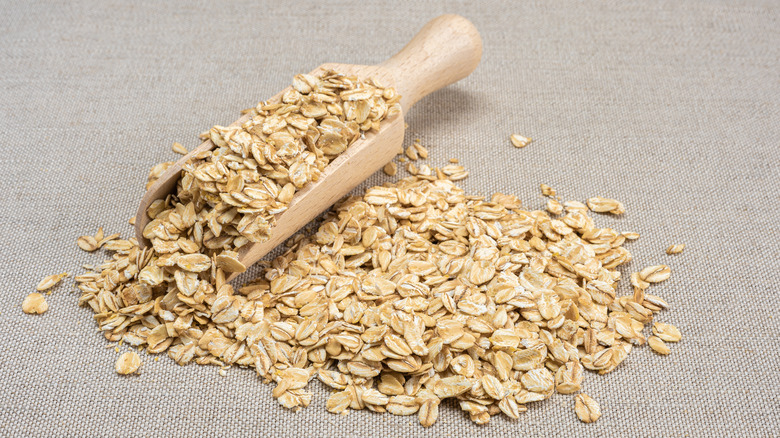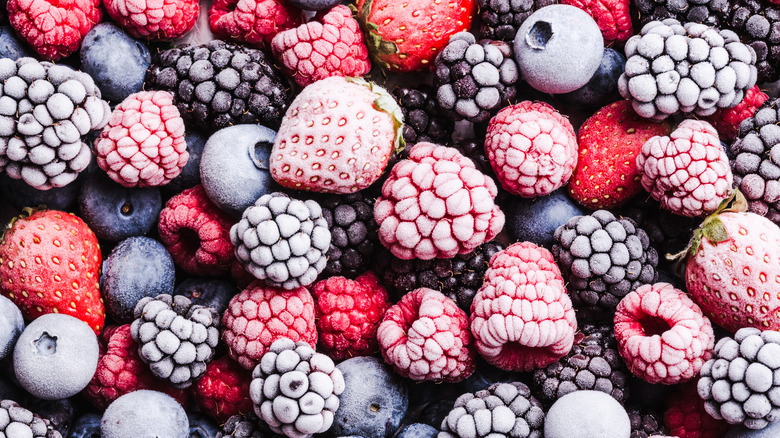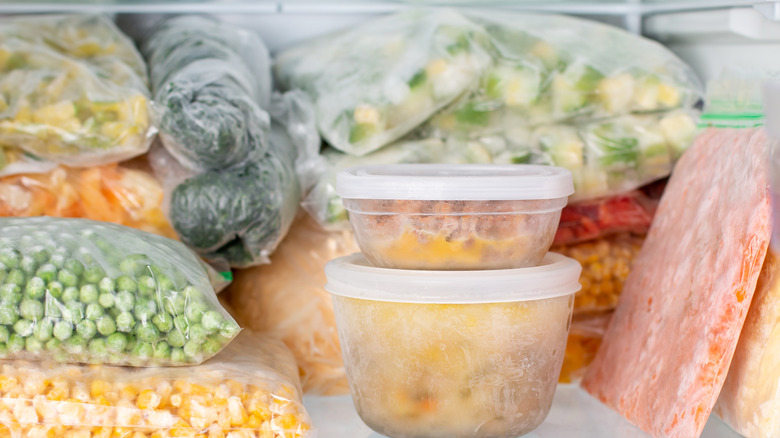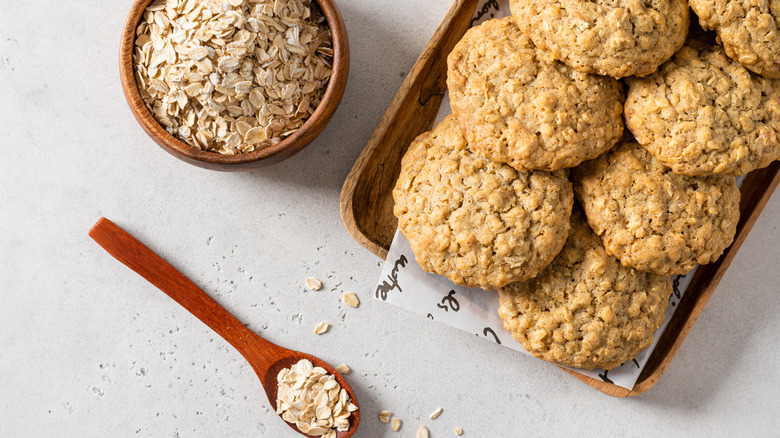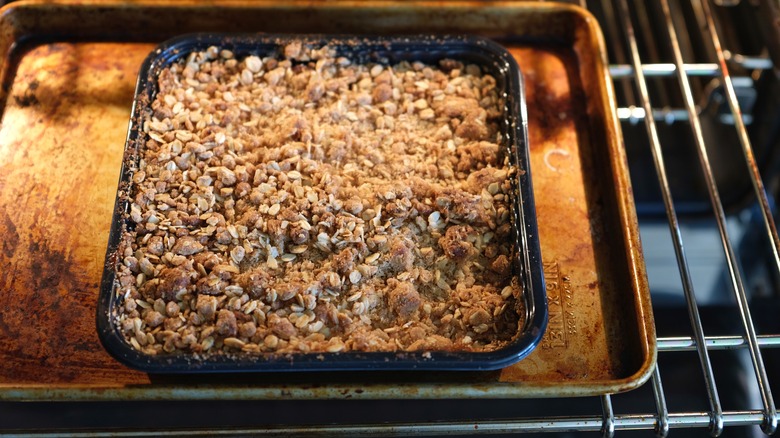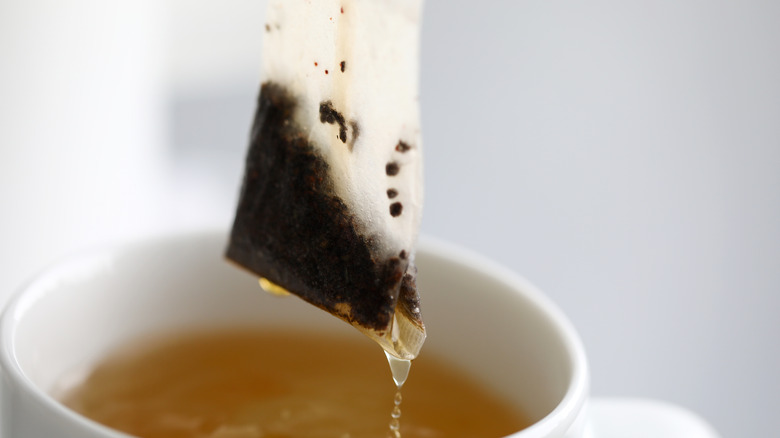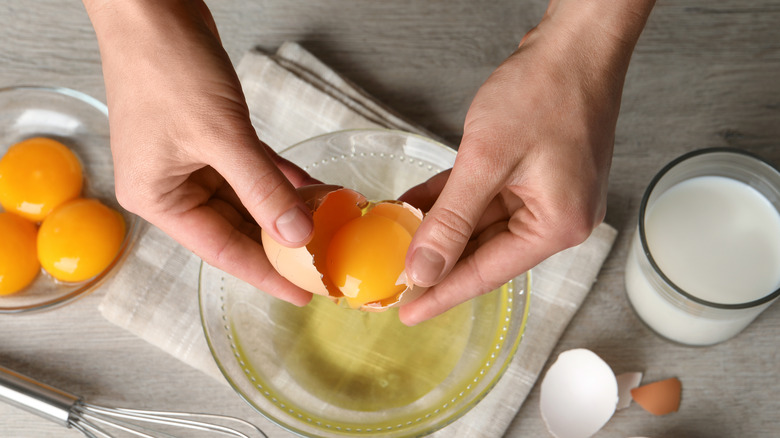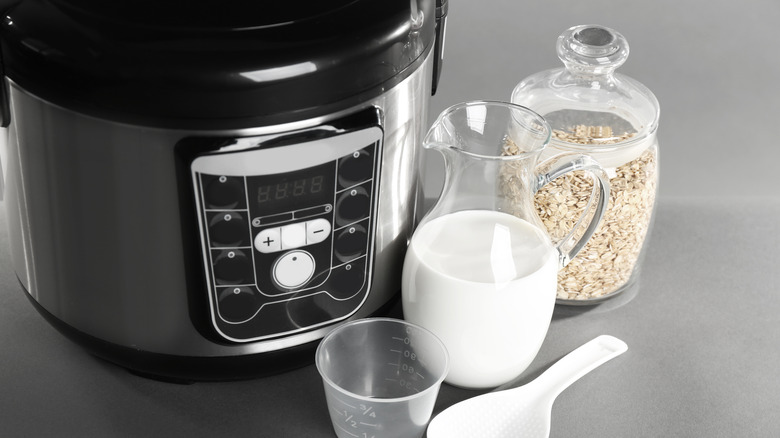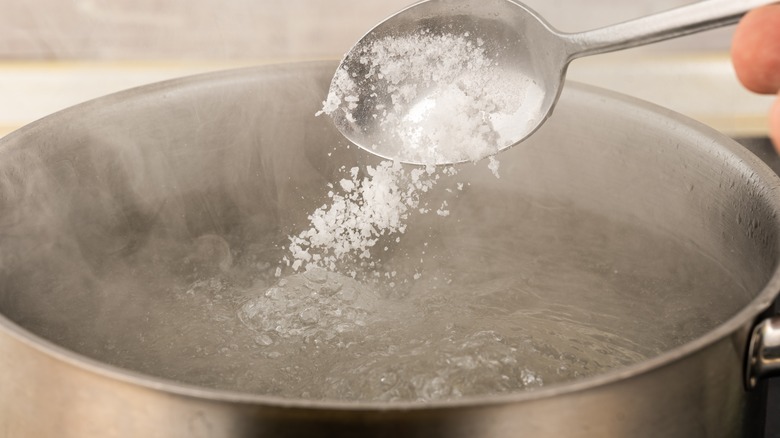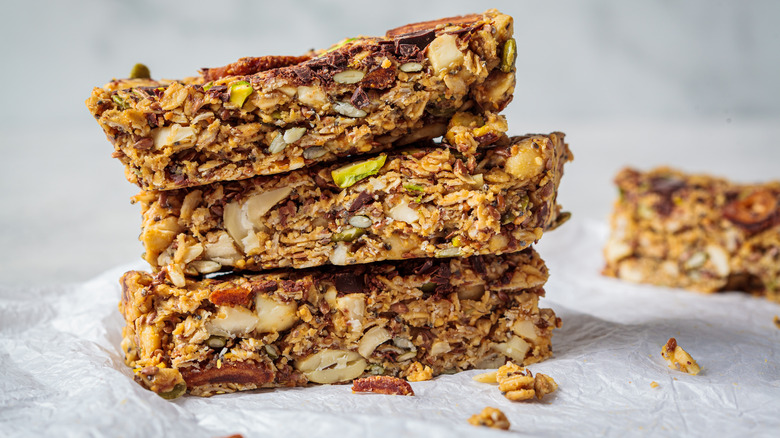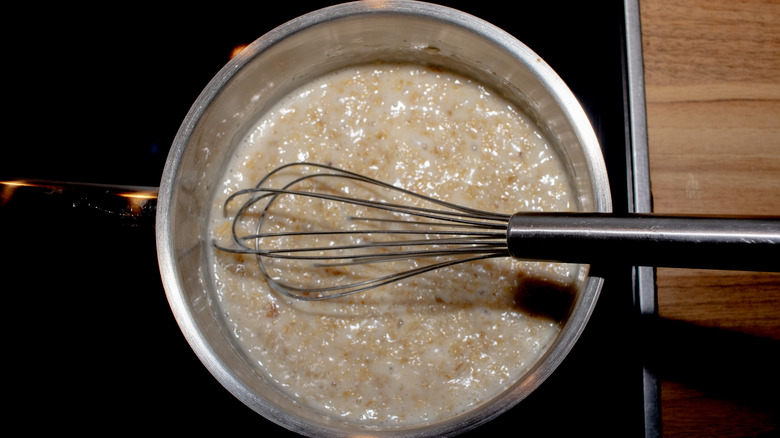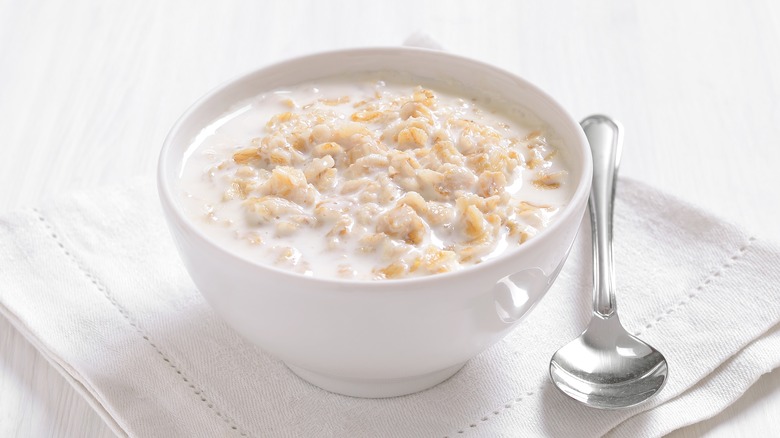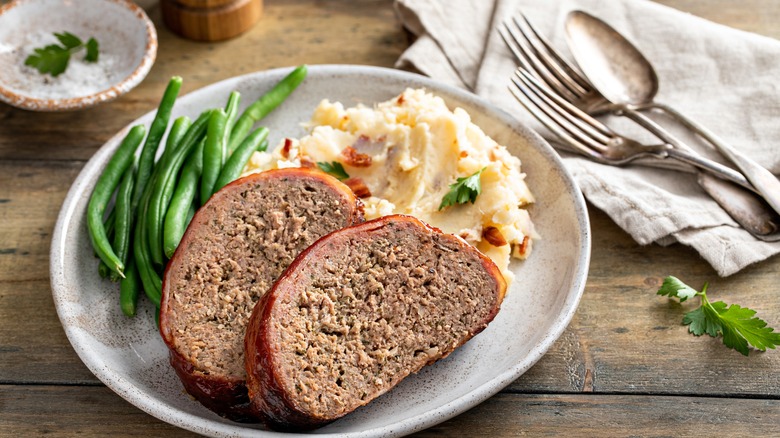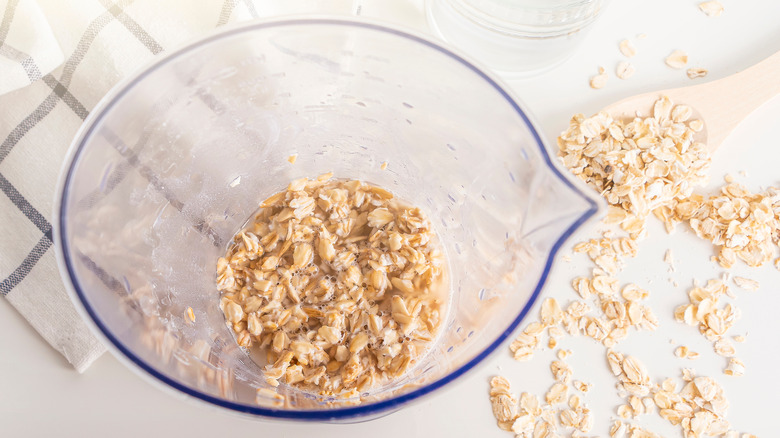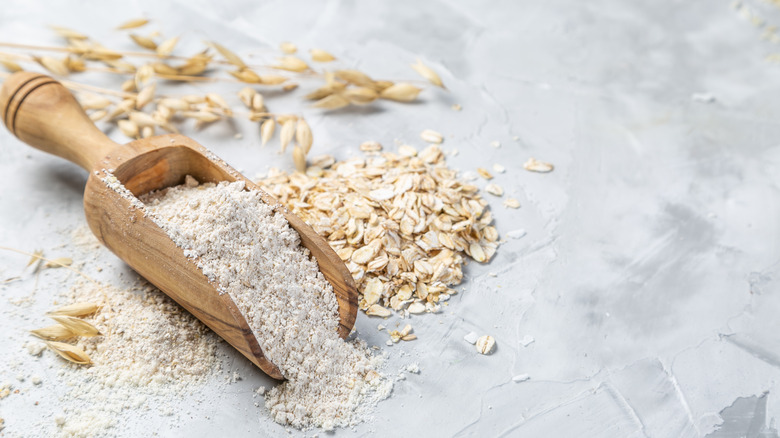15 Absolute Best Tips For Cooking With Oatmeal
Oatmeal is a classic breakfast food known for its wholesome, filling, and customizable qualities. But this grain deserves a bit more credit for its utility in various other culinary applications, including baking and cooking. Once combined with water and heat, oatmeal develops a fibrous, glutenous consistency that allows it to bind together other ingredients and retain moisture well. These qualities make oatmeal a filling meal and an invaluable ingredient for your pantry.
It's important to note that there are minute differences in the processing step for different kinds of oats at the store like rolled, instant, and steel-cut oats. Instant oats are pre-cooked for easy prep the morning you need them, while rolled oats are slightly thicker and not cooked. Steel-cut oats have a chewier texture than the others and require the most cooking since they are neither steamed nor flattened. Thankfully, there are plenty of ways to use each type, and below you'll find our favorite tips for cooking with oatmeal.
Use freeze-dried or frozen fruit for a low-prep oatmeal breakfast
Preparing breakfast for a busy morning can be challenging — especially if you have to undergo the laborious process of chopping up individual fruits to add to your bowl of oatmeal. If you want fruity oatmeal without any prep, try using frozen or freeze-dried fruit instead. Then, add your fruit of choice to your oatmeal before you pop it into the microwave for a blast of flavor and a ton of extra time saved.
You shouldn't worry about the nutritional content of frozen or freeze-dried fruit either since it's essentially similar to that of the fresh stuff. In fact, a study published by the American Frozen Fruit Institute indicates that some vitamins like vitamin C, vitamin A, and folate are higher in frozen fruit than in fresh fruit. Plus, frozen fruit is often cheaper and allows consumers to purchase produce that would otherwise be out of season.
Freeze your oatmeal ahead of time for busy mornings
Cooking oatmeal on the stove is one of the last things you want to do when you're getting ready for work or class. If you are a serial planner, you might consider how you can make oatmeal the night before to expedite your morning routine. And the answer to your problem doesn't always have to mean overnight oats. Instead, the trick for prep-cooking oatmeal for busy mornings is to freeze it.
Start by batch-cooking your oatmeal for the week; you can prepare as many or as few servings as you need. Be sure to adequately cool the oatmeal before transferring it to a silicon muffin tin or ice mold. Then, transfer the cubes to your container of choice. When you need to make oatmeal for breakfast, all you'll need to do is microwave the cubes for a few minutes. Frozen oatmeal can last up to three months in your freezer, so you'll always be prepared when the mood strikes.
Stick to old-fashioned oats for a chewy cookie
Oatmeal raisin cookies have plenty fans as well as detractors. But what's not divisive about these cookies is the type of oats you should always use for them. Old-fashioned oats will result in a chewier cookie than other types of oats. Quick oats are more heavily processed and absorb water more quickly. This pulls some of the moisture from the dough and causes the cookie to come out of the oven with a much different texture than the old-fashioned oats. You'll end up with cookies that are much more cake-like, plush, and don't spread as much.
Old-fashioned oats produce a chewier cookie because the oats are much thicker than the quick-cooking variety. You just won't get the same texture if you use powdery instant oats. Steel-cut oats are not a viable option for baking oatmeal raisin cookies because they require significantly more cooking time and added moisture than the other types.
Toast your oats for better flavor
Everyone is looking for ways to elevate their breakfast from ordinary to fantastic. Most people make their oatmeal more exciting by sticking to fun toppings — like fresh fruit, honey, or the classic brown sugar. But one of the best ways to upgrade your oatmeal is to toast the oats.
This process works best for hearty oat varieties like rolled or steel-cut. Start by placing the oats in the skillet and tossing them over medium-high heat until they start to emit a warm and toasty odor. Always continuously toss your oats to ensure they get nice and golden brown and don't burn. You can also place the oats on a baking sheet and bake them for about ten minutes at 350 degrees Fahrenheit until they turn golden brown.
If you prefer a more buttery flavor from your oats, you can toss them in coconut oil or butter in the pan before adding your liquid of choice. Then, once the oats start getting toasty, cook them as you normally would.
Cook your oats in tea for more flavor
Many folks like to start their mornings with a bowl of oatmeal and a warming, caffeinated beverage like tea. But what if we told you that you could have the best of both worlds and integrate your favorite herbal pick-me-up into your morning bowl of fiber?
You can use tea to transform your oatmeal by steeping a couple of tea bags in boiling water for a few minutes and using the liquid for cooking your oats. You can make an infusion with milk and tea bags if you prefer overnight oats instead of hot oats, too. Be sure to allow the mixture to cool adequately before adding your oats and placing the jar in your fridge overnight.
You can use any of your favorite types of tea for this hack. Chai tea is one of our favorites because you can complement it with a sprinkle of cinnamon on top of your oatmeal. However, if you prefer the darker side of tea, try an English breakfast complemented with honey and milk.
Avoid continuously stirring your oatmeal
Making a good bowl of oatmeal is all about refining your cooking method. So, you would think that a bowl is relatively simple to make — just add the oats, the liquid, and the flavoring ingredients to the pot and cook away. But, some minor technical concerns may be the real reason why your oatmeal turns out chewy.
One of the major mistakes people make with oatmeal is stirring it too much while it's cooking. Moving the oats around in the pan will cause the grains to release a gluey starch, making the oats harder and harder to stir. This will result in a texture that is disappointing and sticky instead of creamy and smooth. Instead, you should only stir the oats once or twice during the entire cooking process. Otherwise, let the heat from the stove do its magic in creating a bowl of silky smooth oatmeal.
Add eggs to your oatmeal for a boost of protein
Oatmeal has a ton of fiber that will keep you satiated for an extended time period. But adding an additional boost of protein will further improve that satiety. Eggs are a filling way to complete your breakfast and elevate your oatmeal — and you don't have to eat them on the side.
Mixing oatmeal together rather than scrambling them separately is the key to adding eggs to your oatmeal. You'll want to use rolled oats for this recipe, but instant oats or steel-cut oats may also work in a pinch. Cook the oatmeal in the liquid until the liquid is fully absorbed; this will take upwards of seven minutes, or slightly longer if you plan to use steel-cut oats. Then, whisk in the egg (for a whole egg, be sure to first mix the yolk and the white in a separate bowl) and stir vigorously until well combined. If you're using egg whites only, you should plan to use a quarter cup of whites for each half-cup of dry oats.
Make your oatmeal for a crowd in a slow cooker
Having an oatmeal bar at your next brunch event is a low-cost option that comes with a ton of customizations. Serve your oatmeal with cut fruit, nuts, and sweet toppings for your guests to build their own bowls. But the more obvious question is: How are you supposed to make that much oatmeal? Heating it in your microwave is out of the question while cooking it on your stove will take a long time and cost you the feeling in your arm after having to stir it. The ideal appliance for cooking oatmeal for a crowd is actually your slow cooker.
You should make oatmeal in a slow cooker for several reasons. It will keep your oatmeal warm and soft for several hours, which is perfect if people won't eat it simultaneously. The extended cooking time of the slow cooker will also keep the oatmeal smooth and creamy rather than dense and chewy. For old-fashioned rolled oats, use an oat-to-water ratio of 1-to-3. Leave your slow cooker on low for eight hours. If you're using steel-cut oats, you'll have to use slightly more water; a ratio of 1-to-4 is appropriate.
Add a pinch of salt for better flavor
Salt is a beneficial ingredient in the kitchen. Although you would think that this ingredient would be kept separate from sweet additions like berries and honey, adding a pinch of salt to your oatmeal will actually bring out the flavors more and help enhance the sweet notes of your toppings.
Most oatmeal recipes will note that you should add salt to the oatmeal but may not specify when exactly to do so. Adding salt to the oatmeal when you start cooking rather than towards the end is best. This will give the salt the most time possible to work its magic on the oats. Most recipes will also specify that you add a "pinch" of salt. For the folks among us who love to be precise in the kitchen, this is about a fourth of a teaspoon. Kosher salt is our go-to for oatmeal because it has a less sharp flavor than other varieties.
Try baking your oatmeal in an air fryer
Not all oatmeal has to have the soft, mushy texture we often associate it with. If you want a bit more texture and crunch, you should try making your oatmeal in an air fryer. This cooking method will give you the same texture as baked oats and resemble a soft granola bar. Plus, you'll save a ton of time making breakfast using your air fryer instead of your household oven. Start by buttering an oven-safe dish and preheating your air fryer to 300 degrees Fahrenheit. Once you add your oats and liquid mixture to the air fryer, you'll just have to wait about 15 minutes for a delicious breakfast.
Baking your oats in the air fryer allows many ways to customize your breakfast. If you're feeling like eating these oats as a snack, we recommend adding some dark chocolate pieces to the mixture; it's heavenly when the chunks melt into the rest of the bar. You can also add a protein-rich addition like peanut butter to help keep you satiated.
Use the right ratio of liquid to oats
One of the most common mistakes people make with oatmeal is using the wrong amount of liquid per the amount of oats. This measurement depends on the type of oat you're cooking with; more finely ground oats, like the instant variety, will require much less liquid than a dense, hearty steel-cut oat.
Instant oats and old-fashioned oats utilize a 1-to-2 ratio of oats to liquid. This means that for every half-cup serving of oats you use, you should use one cup of liquid. If you want oats that are a bit more wet, you can use more water. Some variations on the recipe, such as for Scottish oatmeal, use a 1-to-3 ratio of oats to liquid. If you're using steel-cut oats, also called Irish oatmeal, you'll need to use a 1-to-4 ratio of oats to liquid to account for the density and texture of the oats.
Always cook oatmeal in water
The decision to use water or milk for oatmeal is often based on personal preference. Some folks claim that opting for the latter makes it deliciously creamy, but we would like to argue that you should never cook oatmeal in milk. If you cook your oatmeal at too high a temperature, you risk scalding it and imparting an unpleasant taste to your breakfast. The proteins and fats in the milk can also make it more glue-like and sticky rather than creamy — which is a texture that's far from pleasant.
You don't have to avoid milk entirely. Instead, you can cook the oatmeal in water and add a splash of milk to the bowl after cooking the oats. You'll still get the protein boost of using the milk without the cement-like texture. If you're after an unctuous flavor in your oatmeal, try adding a splash of half-and-half instead of milk after your oatmeal is finished cooking.
Add it to meatloaf
One of the best uses for oatmeal isn't actually for breakfast — it's for dinner. Swapping breadcrumbs for oatmeal is an easy way to upgrade your meatloaf instantly. Usually, the breadcrumbs, or milk-soaked pieces of bread, are added with the other ingredients to help bind all of the components of the meatloaf together. But if you go with this traditional route, you may find that the binding quickly disintegrates and does not hold together well. Using oatmeal as a binder in the meatloaf is a much better option because it provides more structure and moisture. In addition, when exposed to heat, the oatmeal does not release moisture, thus acting as a superior binder.
If you plan to swap in oatmeal, you will want to use fast-cooking rolled oats because of the meatloaf's short cooking time. If you're hosting a gluten-free dinner, be sure that the oats you purchase and use in your meatloaf are certified gluten-free.
Soak your oatmeal for a better consistency
If you're not on the overnight oats train, you must jump on at the next stop. Soaking oatmeal overnight was a common practice for making oatmeal but was removed from the culinary lexicon as people opted for more quick and convenient ways to make breakfast in the morning. But, using a 1-to-1 ratio to make overnight oats is an easy way to make a museli-like ingredient for your yogurt or your smoothies. If you want a more complex flavor, add a few tablespoons of yogurt to your mixture and let it lacto-ferment overnight on your counter.
Soaking your oatmeal isn't just an essential step for making a bowl of overnight oats; it can also positively impact your next batch of moist oatmeal muffins. Soak your oats in milk for at least 20 minutes before making your muffins to help tenderize the oats. This method will also help keep the oats soft and less absorbent during baking.
Use oat flour in your oatmeal raisin cookies
Oats have given us so many other delicious foods like oat milk, oat yogurt, oat ice cream — and, of course, oat flour. Oat flour is a simple pantry staple you can make if you can access a high-powered blender. Just add oats to your blender and pulse until a fine powder forms to make oat flour. Use oat flour in your recipes as a gluten-free, fiber-rich replacement for white flour.
One of our favorite ways to use oat flour is to add it to oatmeal raisin cookies. The addition will give the cookie a more fluffy, cake-like consistency. However, since the oats do not contain gluten, you should expect the cookie dough to feel less stretchy. If you want to retain some of the chewiness to your cookie, use a small portion of oat flour rather than a complete 1-to-1 swap.
